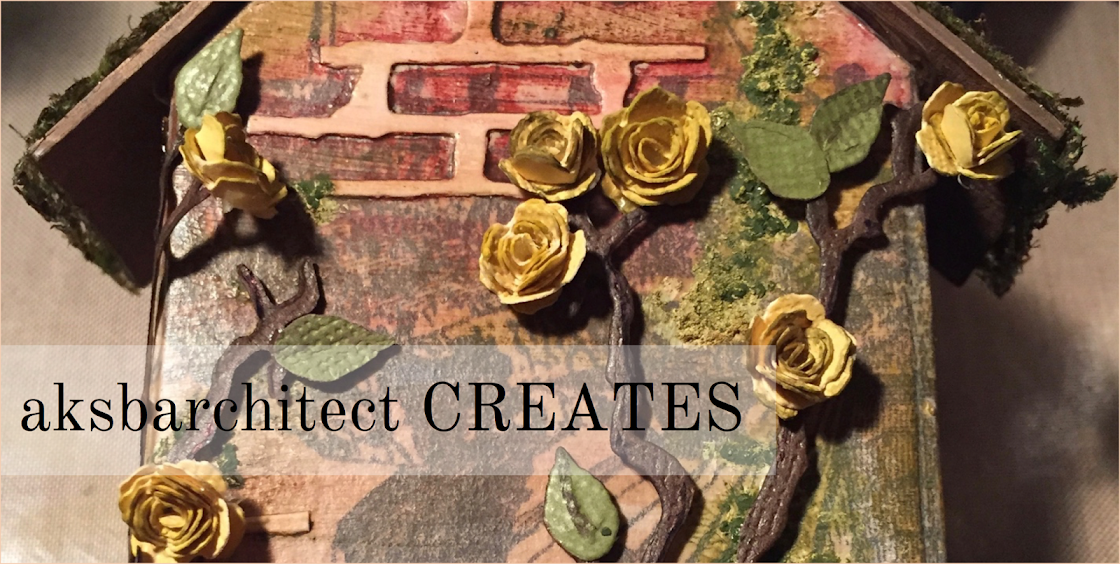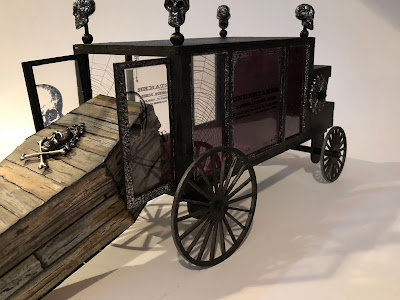As October marches on, there is a shift, of sorts, in the atmosphere. The leaves begin to die; the days grow shorter; and we prepare ourselves for the long winter nights. It is with the fading of the bright and active autumnal days that I present to you "caravan to the catacombs."
Whenever I begin a new project , I always find it helpful to initially construct the piece in its unaltered form. Figuring out the puzzle and understanding the basic construction helps me to determine the order in which I will need to complete the parts. It’s also helpful to get a clear vision of how it will look in it’s 3D form.
I paint all of the pieces with black soot distress paint on both sides, making sure to paint the edges of the interlocking tabs so that when assembled, it is completely colored. The pieces are set aside to dry.
I cut 4 rectangles from acetate that has a spider web pattern printed on it. I love the papers included in the new Halloween paper stash from Tim Holtz. Each rectangle is approximately 1-5/8" x 3-1/4”. I also cut two 2-7/8” x 3-1/4” pieces of clear acetate for the central windows on each coach side panel. The clear panels are stamped with “The Undertaker“ stamp, and adorned at each corner with remnant rub decorative corners.
Each of the openings in the side walls is edged with Versamark ink and heat embossed with Emerald Creek hammered metal embossing powder. This gives the window openings a spooky elegance. When the embossing has cooled, I flip the side panels over and adhere the acetate pieces in place with distress collage medium.
With the side panels complete, I begin to construct the base of the coach. Both of the runners that will hold the axels are glued in place. Be sure to check that both runners are oriented in the same direction. The smaller hubs are where the larger wheels are located, and the larger hubs are where the smaller wheels will be. Next, I attach the side panels, as well as the wall that separates the driver from the coffin compartment. The interlocking tabs assure that everything is aligned correctly.
The solid surfaces on the interior of the coffin compartments are lined with a burgundy cut velvet. I measure and cut two pieces of cardstock that fit the floor area and partition wall then adhere the velvet to the cardstock with collage medium. When dry, I trim the edges and adhere each piece to its respective panel in the coach. The rear doorframe is attached after these velvet pieces are secure.

When the coffin and lid have been completely covered, a jolly roger embellishment is adhered to the lid and a skeleton is nestled into his final resting place.
This coffin box slides right into the rear compartment of the funeral coach, allowing the doors to close fully.
I paint all of the pieces with black soot distress paint on both sides, making sure to paint the edges of the interlocking tabs so that when assembled, it is completely colored. The pieces are set aside to dry.
I cut 4 rectangles from acetate that has a spider web pattern printed on it. I love the papers included in the new Halloween paper stash from Tim Holtz. Each rectangle is approximately 1-5/8" x 3-1/4”. I also cut two 2-7/8” x 3-1/4” pieces of clear acetate for the central windows on each coach side panel. The clear panels are stamped with “The Undertaker“ stamp, and adorned at each corner with remnant rub decorative corners.
Each of the openings in the side walls is edged with Versamark ink and heat embossed with Emerald Creek hammered metal embossing powder. This gives the window openings a spooky elegance. When the embossing has cooled, I flip the side panels over and adhere the acetate pieces in place with distress collage medium.
The solid surfaces on the interior of the coffin compartments are lined with a burgundy cut velvet. I measure and cut two pieces of cardstock that fit the floor area and partition wall then adhere the velvet to the cardstock with collage medium. When dry, I trim the edges and adhere each piece to its respective panel in the coach. The rear doorframe is attached after these velvet pieces are secure.
The rear door panels are embossed with hammered metal on their exterior sides. Pieces of stamped acetate are adhered to the openings in the same manner as they were on the sidewall openings. When everything is dry, the doors are hinged in the doorframe.
I want the wheels to look as if they have somewhat worn, as if they have travelled many miles. To accomplish this, the four wheels are lightly painted with black soot distress paint on both sides. The outer edge of each wheel is colored using an brushed pewter distress crayon. Some areas of the wheel/spoke interior edges are also colored with the distress crayon, using a paintbrush and water to make the pigment more fluid. The paintbrush can easily access the tight areas between the spokes.
The compartment beneath the drivers seat is finished with cut velvet in the same fashion as the rear compartment. A metal Halloween vignette adornment is adhered to each side of the cab with collage medium.


The coach would not be complete without a “vanity plate”, which is located on the front grill panel. A Halloween quote chip is adhered to the painted chipboard panel and hammered metal embossing powder creates the faux grill effect.
A Gypsy Soul Laser Cuts 6 inch coffin box fits perfectly inside the funeral coach. This piece is made from lighter weight chipboard and arrives in two flat pieces. Each piece has score lines at every fold location. I recommend using a bone folder to score along the lines prior to assembly.
I assemble and paint the coffin box with black soot distress paint. Using black soot archival ink, I stamp a wooden plank pattern onto a piece of mixed media heavy stock. I color the piece with weathered wood, black soot, hickory smoke and gathered twigs distress inks to create the look of real wood. My patterned paper is cut to fit the top and bottom of the casket and planks are individually attached to the sides.

When the coffin and lid have been completely covered, a jolly roger embellishment is adhered to the lid and a skeleton is nestled into his final resting place.
This coffin box slides right into the rear compartment of the funeral coach, allowing the doors to close fully.
Once everything is intact, I attach the "metal" skull decorations at each roof corner with collage medium and allow them to dry overnight.
The funeral coach, complete with "passenger" is ready to for its caravan to the catacombs.
Thank you so much for taking the time to visit the blog.
If you still haven't had a chance to make something for this spooky season, I hope that you can find the time; its always a fun time of year to let your creativity take flight.
I hope that you are inspired to create something spooktacular!
~Ann
supplies list:
burgundy cut velvet
distress collage medium
distress crayon: brushed pewter
distress inks: black soot, gathered twigs, hickory smoke, weathered wood
distress paint: black soot
Emerald Creek hammered metal embossing powder
Gypsy Soul Laser Cuts products:
Funeral Coach, 6 inch Coffin BoxThe funeral coach, complete with "passenger" is ready to for its caravan to the catacombs.
Thank you so much for taking the time to visit the blog.
If you still haven't had a chance to make something for this spooky season, I hope that you can find the time; its always a fun time of year to let your creativity take flight.
I hope that you are inspired to create something spooktacular!
~Ann
supplies list:
burgundy cut velvet
distress collage medium
distress crayon: brushed pewter
distress inks: black soot, gathered twigs, hickory smoke, weathered wood
distress paint: black soot
Emerald Creek hammered metal embossing powder
Gypsy Soul Laser Cuts products:
skeleton beads
Tim Holtz ideaology:
adornments jolly roger, gothic remnant rubs, halloween paper stash, vignette accents halloween, heirloom roses halloween, halloween quote chips,
Tim Holtz/Stampers Anonymous rubber stamps:
craze and planks (CMS344), regions beyond (CMS274), undertaker, (CMS240)
Versamark embossing ink
wooden beads







































